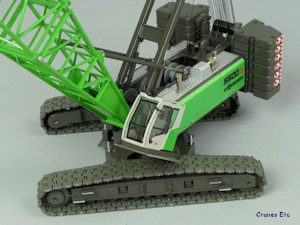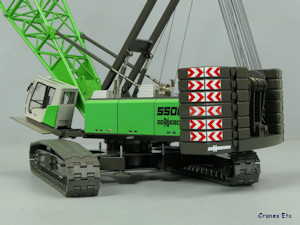 |
|
Sennebogen branded
box. |
 |
 |
|
Rigged with a boom only. The cab mecahnism is
loose so it struggles to hold a horizontal pose. |
 |
| Raised on its
jacks. |
|
|
 |
| Crawler tracks
and lattice sections.
|
 |
| Holes for the
winch keys in the body. |
 |
| Tilting cab. |
 |
| Boom extended
with jib parts. |
 |
| Maximum luffing
jib configuration.
|
 |
| Jib luffing
gear. |
|

The scale model of the Sennebogen 5500 was
the first mass-produced large crawler crane model and it
appeared as a prototype at the BAUMA exhibition in 2001,
and went on sale in 2002.
This 5500G version
is updated with some revisions to the 'Go for Green'
revision of 2012.
Packaging
The box sleeve is Sennebogen branded and
contains two
polystyrene trays which have a large number of
individual pieces securely packed. Surprisingly,
the two extra counterweight pieces included with this
version of the model were packed loose and unprotected meaning
that some collectors may receive parts with paint chipped during
shipping.
There were no defects or missing parts on the review
model.
A detailed instruction sheet is provided, complete with
pictures, and it is in German and English. It is
not revised for this version of the model. It does not describe all aspects of the
assembly such as
which winch drums to use. The winch drums should be
used as follows (numbering the winch drums 1 to 4 from front to back):
- 1
is used for the hook when there is only a main boom or
for the hook for the luffing jib if the crane is
using two hooks;
- 2 is used for the hook on the main boom when the
luffing jib is attached;
- 3 is a
double drum and controls the luffing of the main boom
using the pulleys on the A-frame (except the centre
pulley);
- 4 controls the luffing jib - the rope
goes under and around the single pulley on the body
and then up and over the centre pulley on the A-frame
and on up to the luffing gear pulleys.
Two drums have rope installed out of the box, and two
spools of rope are supplied for the other two. On
the review model surprisingly there was not enough rope
pre-installed on the jib luffing drum to facilitate a
full range of movement.
Detail
Each crawler track comes as a separate unit. The tracks
themselves are plastic made up of a large number of
interlocking sections. They look very good although
they are occasionally a little stiff so do not always
lie naturally. The only other moving parts on the track
frame are the main sprockets.
The main piece of the model crane consists of the cross
frame that links the two track frames, the crane body and first section
of boom. The cross frame snaps into position into
openings in the track frames and this provides a robust
fixing mechanism. The self-raising jacks are
simple screw threads which are crude by modern
standards.
The cab design is new on this version. It
is metal
with grab rails and an unsilvered mirror, and good interior details such as foot
pedals. The main body is relatively uncomplicated
except at the rear where the counterweight attachment
mechanism is modelled well, and is complete with cylinders and
lifting chains although the plastic cylinder pistons would look
better if they were silver.
Four separate winches are available to be used,
and there are holes in the body to allow entry of the
operating keys. The pulleys on the body and A-frame are
metal rather and they roll freely.
The counterweight plate attaches with a pin and
pairs of six weights
sit on top, including the new larger plates which are
part of the 5500G. For some reason the graphic
chevrons on the new plates are slightly off colour. Each counterweight
piece is cast with useable lifting lugs. Not included on the
model are the ballast plates used on the real machine
which span between the track frames front and rear.
The first section of
the main boom is permanently fixed to the crane body
together with spring-loaded bars to prevent the boom
being over luffed into a vertical position. All sections of
the boom are made extremely well and look fine.
They join together using the plastic pin system which is
very effective.
The main boom head has
snap-in large plastic pulleys which are satisfactory but
perhaps not the best in their ability to free-roll, and they also appear to have an
over-large separation between the sheaves.
With the luffing jib attached an excellent cable
arrangement is provided to prevent the jib over-luffing
but on the review model the two upper ropes were not the
same length.
The
pendant bars used to support the boom and jib are all modelled
in tough plastic. They are pinned together so they
remain straight under tension.
There is no dolly wheel at the end of the fly
jib and this would have been a worthwhile addition.
The hook is only
a single pulley affair but looks smart with chevron
stripes. It is metal and looks fine on
the fly jib but the main boom really calls for something
larger. The pulley inside the hook is plastic and
would not turn on the review model.
Features
The
tracks roll well by hand and work very well when the
crane is built up. The jacks lower by unscrewing.
The cab is mounted on a tilting and hinge arrangement so
that it can be moved inward to reduce the crane width
during transport and can be rotated upward to a steep
angle to aid the
driver during lifts at height. The mechanism was
loose when the cab is horizontal so it drooped down a
bit. It would have been nice if the walkway outside the cab
had been hinged so that it can be stowed during
transportation.
The four winches are operated by keys which are metal. They can also be
removed when not used so they do not distract from the
look although the holes remain. To insert the key
in the jib luffing winch requires pushing out the
internal axle so care is needed not to push it too far.
The luffing gears work well due to the free-rolling
metal pulleys. The hook function is poor because
of the plastic pulleys used.
The main strength of this model is the large variety of
ways the model can be displayed. It can be broken down
for transport so looks very good on appropriate
haulage vehicles. It can also be displayed in various
stages of assembly.
The crane can be rigged a number of ways. It can have
just a main boom of various lengths, including very
short if you want it. It can have a luffing
jib of different lengths giving an overall model height
of about 1.2m. Another option arises because the
reducer section at the top of the main boom can have jib
sections directly attached to create a long boom
with reducing section towards the top. Under this
configuration the model stands around 1.1m high.
In terms of stability the model is fine and is improved
by the addition of the two new counterweights.
Quality
The casting of the boom
sections is very good and overall the model has a quality feel.
The Sennebogen
green paint scheme looks really good
and the few graphics are sharp.
Price
The price of the model has increased significantly with
this revision and this is not accounted for by the
limited improvements which have been made.
Overall
This model has been in production for around 17 years
since its first release. This version has a
few incremental improvements since the upgrade in 2011,
and a significant price increase. It remains a good
looking, flexible model.
However, it is disappointing that Conrad did not do more
to modernise and improve the model given that many
changes could have been low cost.
Footnotes
The Sennebogen 5500 crawler crane was originally
introduced in 2002 in
yellow and grey livery and was reviewed
here.
In 2011 an updated version was introduced.
This updated version, the 5500G, was introduced for
Bauma 2019.
|
|
 |
|
|
 |
| The contents. |
 |
| Decent looking
load. The Arocs truck is in Sennebogen colours.
|
 |
| Counterweight
and lattice sections. |
 |
| Overall look is
very good. |
|
|
 |
| Textured
walkway surfaces. |
 |
| Small hook for
a big boom. It is better to only fit two pulleys on the
boom head so they roll properly. |
 |
| Plastic sign
boards on the jib. |
 |
| Overall profile
is very good. |
|

